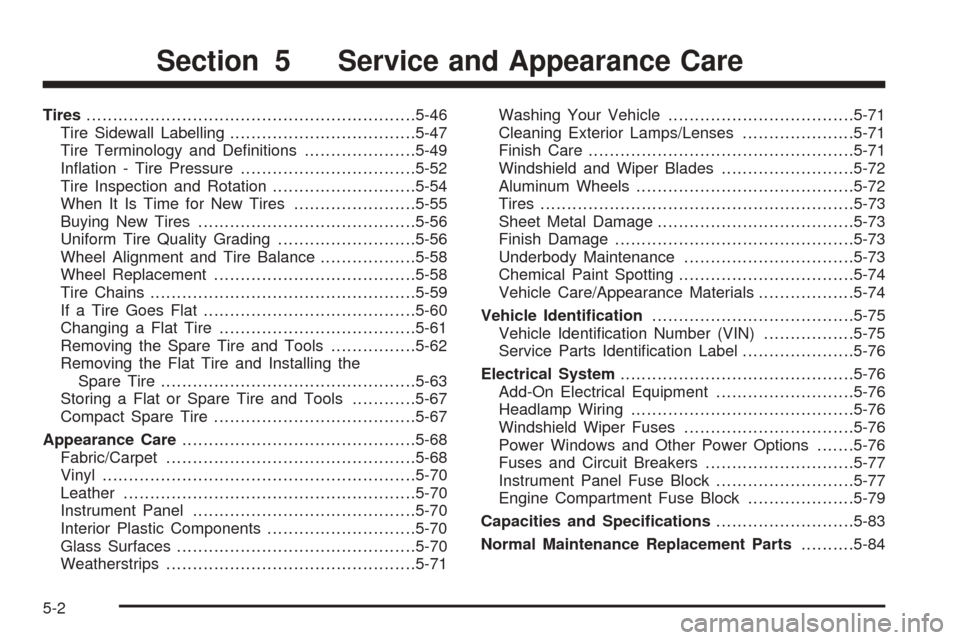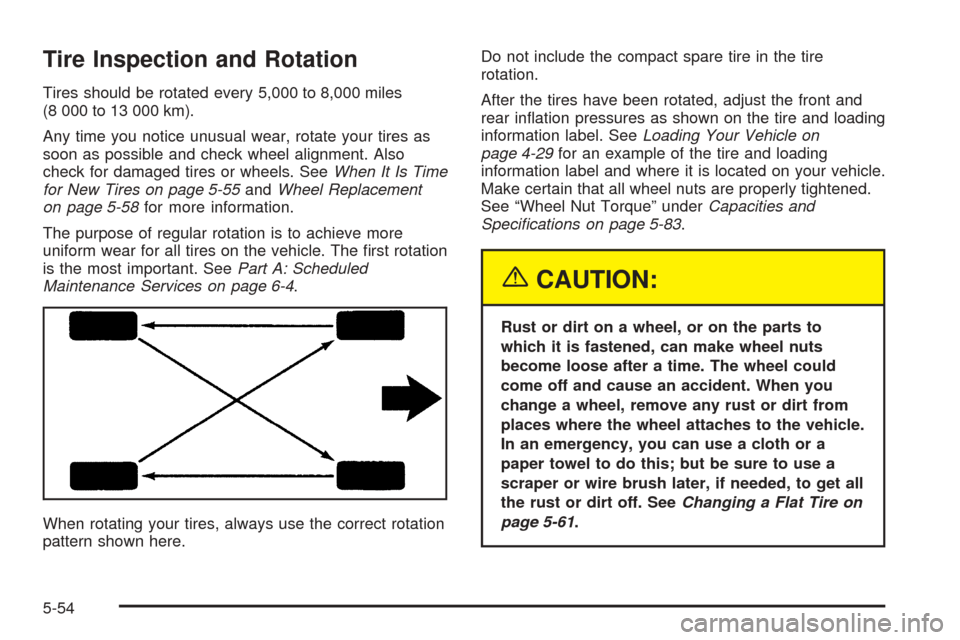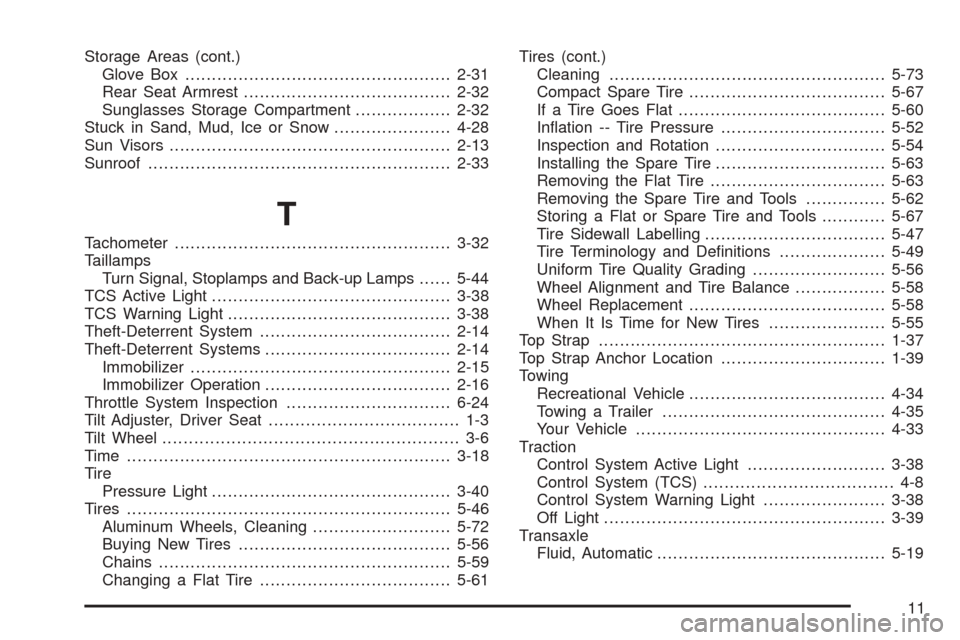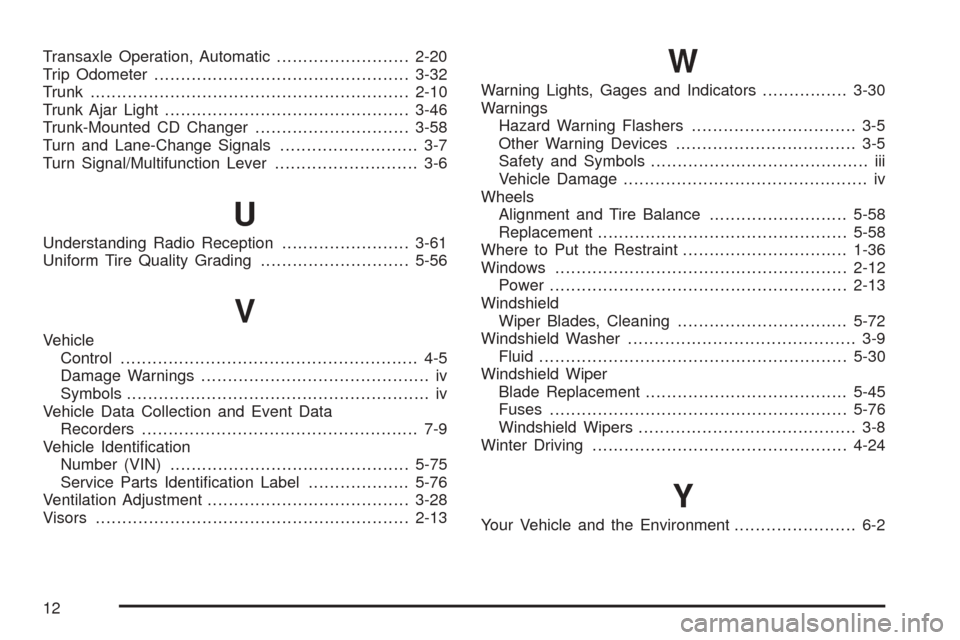wheel alignment CHEVROLET EPICA 2005 1.G Owners Manual
[x] Cancel search | Manufacturer: CHEVROLET, Model Year: 2005, Model line: EPICA, Model: CHEVROLET EPICA 2005 1.GPages: 340, PDF Size: 2.19 MB
Page 204 of 340

Tires..............................................................5-46
Tire Sidewall Labelling...................................5-47
Tire Terminology and Deļ¬nitions.....................5-49
Inļ¬ation - Tire Pressure.................................5-52
Tire Inspection and Rotation...........................5-54
When It Is Time for New Tires.......................5-55
Buying New Tires.........................................5-56
Uniform Tire Quality Grading..........................5-56
Wheel Alignment and Tire Balance..................5-58
Wheel Replacement......................................5-58
Tire Chains..................................................5-59
If a Tire Goes Flat........................................5-60
Changing a Flat Tire.....................................5-61
Removing the Spare Tire and Tools................5-62
Removing the Flat Tire and Installing the
Spare Tire................................................5-63
Storing a Flat or Spare Tire and Tools............5-67
Compact Spare Tire......................................5-67
Appearance Care............................................5-68
Fabric/Carpet...............................................5-68
Vinyl...........................................................5-70
Leather.......................................................5-70
Instrument Panel..........................................5-70
Interior Plastic Components............................5-70
Glass Surfaces.............................................5-70
Weatherstrips...............................................5-71Washing Your Vehicle...................................5-71
Cleaning Exterior Lamps/Lenses.....................5-71
Finish Care..................................................5-71
Windshield and Wiper Blades.........................5-72
Aluminum Wheels.........................................5-72
Tires...........................................................5-73
Sheet Metal Damage.....................................5-73
Finish Damage.............................................5-73
Underbody Maintenance................................5-73
Chemical Paint Spotting.................................5-74
Vehicle Care/Appearance Materials..................5-74
Vehicle Identi�cation......................................5-75
Vehicle Identiļ¬cation Number (VIN).................5-75
Service Parts Identiļ¬cation Label.....................5-76
Electrical System............................................5-76
Add-On Electrical Equipment..........................5-76
Headlamp Wiring..........................................5-76
Windshield Wiper Fuses................................5-76
Power Windows and Other Power Options.......5-76
Fuses and Circuit Breakers............................5-77
Instrument Panel Fuse Block..........................5-77
Engine Compartment Fuse Block....................5-79
Capacities and Speci�cations..........................5-83
Normal Maintenance Replacement Parts..........5-84
Section 5 Service and Appearance Care
5-2
Page 256 of 340

Tire Inspection and Rotation
Tires should be rotated every 5,000 to 8,000 miles
(8 000 to 13 000 km).
Any time you notice unusual wear, rotate your tires as
soon as possible and check wheel alignment. Also
check for damaged tires or wheels. SeeWhen It Is Time
for New Tires on page 5-55andWheel Replacement
on page 5-58for more information.
The purpose of regular rotation is to achieve more
uniform wear for all tires on the vehicle. The ļ¬rst rotation
is the most important. SeePart A: Scheduled
Maintenance Services on page 6-4.
When rotating your tires, always use the correct rotation
pattern shown here.Do not include the compact spare tire in the tire
rotation.
After the tires have been rotated, adjust the front and
rear inļ¬ation pressures as shown on the tire and loading
information label. SeeLoading Your Vehicle on
page 4-29for an example of the tire and loading
information label and where it is located on your vehicle.
Make certain that all wheel nuts are properly tightened.
See āWheel Nut Torqueā underCapacities and
Speciļ¬cations on page 5-83.
{CAUTION:
Rust or dirt on a wheel, or on the parts to
which it is fastened, can make wheel nuts
become loose after a time. The wheel could
come off and cause an accident. When you
change a wheel, remove any rust or dirt from
places where the wheel attaches to the vehicle.
In an emergency, you can use a cloth or a
paper towel to do this; but be sure to use a
scraper or wire brush later, if needed, to get all
the rust or dirt off. SeeChanging a Flat Tire on
page 5-61.
5-54
Page 260 of 340

Temperature ā A, B, C
The temperature grades are A (the highest), B, and C,
representing the tireās resistance to the generation
of heat and its ability to dissipate heat when tested
under controlled conditions on a speciļ¬ed indoor
laboratory test wheel. Sustained high temperature can
cause the material of the tire to degenerate and
reduce tire life, and excessive temperature can lead to
sudden tire failure. The grade C corresponds to a
level of performance which all passenger car tires must
meet under the Federal Motor Vehicle Safety Standard
No. 109. Grades B and A represent higher levels of
performance on the laboratory test wheel than the
minimum required by law.
Warning: The temperature grade for this tire is
established for a tire that is properly inļ¬ated and not
overloaded. Excessive speed, underinļ¬ation, or
excessive loading, either separately or in combination,
can cause heat buildup and possible tire failure.
Wheel Alignment and Tire Balance
The tires and wheels on your vehicle were aligned
and balanced carefully at the factory to give you the
longest tire life and best overall performance.
Adjustments to wheel alignment and tire balancing will
not be necessary on a regular basis. However, if
you notice unusual tire wear or your vehicle pulling to
one side or the other, the alignment may need to
be checked. If you notice your vehicle vibrating when
driving on a smooth road, your tires and wheels
may need to be rebalanced. See your dealer for proper
diagnosis.
Wheel Replacement
Replace any wheel that is bent, cracked or badly rusted
or corroded. If wheel nuts keep coming loose, the
wheel, wheel bolts and wheel nuts should be replaced.
If the wheel leaks air, replace it (except some
aluminum wheels, which can sometimes be repaired).
See your dealer if any of these conditions exist.
Your dealer will know the kind of wheel you need.
Each new wheel should have the same load-carrying
capacity, diameter, width, offset and be mounted
the same way as the one it replaces.
5-58
Page 339 of 340

Storage Areas (cont.)
Glove Box..................................................2-31
Rear Seat Armrest.......................................2-32
Sunglasses Storage Compartment..................2-32
Stuck in Sand, Mud, Ice or Snow......................4-28
Sun Visors.....................................................2-13
Sunroof.........................................................2-33
T
Tachometer....................................................3-32
Taillamps
Turn Signal, Stoplamps and Back-up Lamps......5-44
TCS Active Light.............................................3-38
TCS Warning Light..........................................3-38
Theft-Deterrent System....................................2-14
Theft-Deterrent Systems...................................2-14
Immobilizer.................................................2-15
Immobilizer Operation...................................2-16
Throttle System Inspection...............................6-24
Tilt Adjuster, Driver Seat.................................... 1-3
Tilt Wheel........................................................ 3-6
Time .............................................................3-18
Tire
Pressure Light.............................................3-40
Tires.............................................................5-46
Aluminum Wheels, Cleaning..........................5-72
Buying New Tires........................................5-56
Chains.......................................................5-59
Changing a Flat Tire....................................5-61Tires (cont.)
Cleaning....................................................5-73
Compact Spare Tire.....................................5-67
If a Tire Goes Flat.......................................5-60
Inļ¬ation -- Tire Pressure...............................5-52
Inspection and Rotation................................5-54
Installing the Spare Tire................................5-63
Removing the Flat Tire.................................5-63
Removing the Spare Tire and Tools...............5-62
Storing a Flat or Spare Tire and Tools............5-67
Tire Sidewall Labelling..................................5-47
Tire Terminology and Deļ¬nitions....................5-49
Uniform Tire Quality Grading.........................5-56
Wheel Alignment and Tire Balance.................5-58
Wheel Replacement.....................................5-58
When It Is Time for New Tires......................5-55
Top Strap......................................................1-37
Top Strap Anchor Location...............................1-39
Towing
Recreational Vehicle.....................................4-34
Towing a Trailer..........................................4-35
Your Vehicle...............................................4-33
Traction
Control System Active Light..........................3-38
Control System (TCS).................................... 4-8
Control System Warning Light.......................3-38
Off Light.....................................................3-39
Transaxle
Fluid, Automatic...........................................5-19
11
Page 340 of 340

Transaxle Operation, Automatic.........................2-20
Trip Odometer................................................3-32
Trunk............................................................2-10
Trunk Ajar Light..............................................3-46
Trunk-Mounted CD Changer.............................3-58
Turn and Lane-Change Signals.......................... 3-7
Turn Signal/Multifunction Lever........................... 3-6
U
Understanding Radio Reception........................3-61
Uniform Tire Quality Grading............................5-56
V
Vehicle
Control........................................................ 4-5
Damage Warnings........................................... iv
Symbols......................................................... iv
Vehicle Data Collection and Event Data
Recorders.................................................... 7-9
Vehicle Identiļ¬cation
Number (VIN).............................................5-75
Service Parts Identiļ¬cation Label...................5-76
Ventilation Adjustment......................................3-28
Visors...........................................................2-13
W
Warning Lights, Gages and Indicators................3-30
Warnings
Hazard Warning Flashers............................... 3-5
Other Warning Devices.................................. 3-5
Safety and Symbols......................................... iii
Vehicle Damage.............................................. iv
Wheels
Alignment and Tire Balance..........................5-58
Replacement...............................................5-58
Where to Put the Restraint...............................1-36
Windows.......................................................2-12
Power........................................................2-13
Windshield
Wiper Blades, Cleaning................................5-72
Windshield Washer........................................... 3-9
Fluid..........................................................5-30
Windshield Wiper
Blade Replacement......................................5-45
Fuses........................................................5-76
Windshield Wipers......................................... 3-8
Winter Driving................................................4-24
Y
Your Vehicle and the Environment....................... 6-2
12